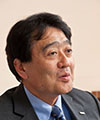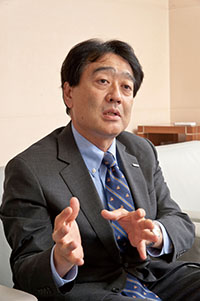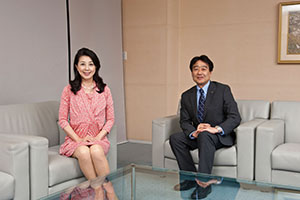 |
|
|
|
|
|
View from the Top Vol. 12, No. 11, pp. 1–5, Nov. 2014. https://doi.org/10.53829/ntr201411tp1  Passing the Ball Forward Towards the Goal of Customer SatisfactionOverviewToday, the information and communication technology (ICT) industry is witnessing increasingly intensifying competition. A company in the industry therefore must consider the customer’s point of view at all times and steer a course through a red ocean market—highly competitive and with defined limits—by making full use of its core strengths. We asked Tetsuya Funabashi, NTT Communications Senior Executive Vice President, about the mindset and strategy that the company must adopt to navigate these rough waters. Keywords: Vision 2015, innovation, cloud Aggressively fostering innovation with execution and implementation in mind—Mr. Funabashi, please accept our congratulations on assuming the office of Senior Executive Vice President. To begin with, please tell us about your goals in this new position. I would like to aggressively foster innovation without being bound by the past. And what I mean by “innovation” is to create an atmosphere that results in people feeling, “Something has changed here—this is great!” with respect to all sorts of company endeavors such as processes, technology development, employee conduct, and customer relations. I myself oversee technology, operations of sales and service, and information security. As for technology and operations, I feel that I can maximize the know-how I built up as head of Customer Services in making these areas of the company even better. Information security, meanwhile, is a field that has a broad and deep range of applications, as you know. I would like to approach this field from a new perspective. Finally, as a basic stance, I will continue to ask myself whether our customers are truly happy with our services, whether they are satisfied with the level of quality that we are offering, and whether there are any areas that we need to improve in our services. —What does the past way of doing things mean to you? And what do you think needs to change going forward? In the corporate world, having ideal objectives in expanding business does not guarantee that those objectives can be met given the limited amount of resources and the various conditions. I mean, in the past, we might have blamed a negative outcome on the external circumstances. In services to date, I feel that there is still much room for improvement and enhancement. What I would like to do is to pool the knowledge and wisdom of all our employees to make improvements and to move forward, even if only by a little, by having the resolve to execute and implement various ideas. No doubt you have heard the word “DevOps” before. As a portmanteau word of “development” and “operations,” it refers to an increasingly popular technique that aims to produce products and services with a high degree of perfection in a relatively short period of time through collaboration between development and operations personnel. I believe that unless we adopt this kind of style that can efficiently drive a project forward while leveraging the strong points of all departments involved, we will not be able to survive in this era of relentless change. I strongly feel the need for making changes to the status quo.
Five pillars of Vision 2015—Based on the stance you just described, what specific forms of operation are you aiming for? ICT and the telecommunications business are being forced into severely competitive conditions while amazing advances in technology continue to take place. I don’t think a company can survive in such an environment unless it keeps the competition in mind and continuously reaches out to its customers. Our financial results for the fiscal year 2013, which ended March 31, 2014, revealed an increase in consolidated revenues for the first time in six years and a record consolidated operating profit for three consecutive years. In fiscal year 2014, we want to see this increase in consolidated revenues continue and to maintain the profit level of fiscal year 2013. With these objectives in mind, we announced our new corporate vision called “Vision 2015.” To achieve this vision, we will promote our Global Cloud Vision (GCV) and work to provide our customers with low-cost, quickly constructed, and customer-tailored ICT environments, centered on the cloud. Specifically, we will promote services that strengthen the link between the network and the cloud in the form of a “carrier cloud.” We will foster the evolution of services that use virtualization technology, including network virtualization techniques such as software-defined networking (SDN) and network functions virtualization (NFV), and we will enhance our efforts in automating operations. Our work here in achieving Vision 2015 will be based on five main pillars. 1. Operations The first pillar is operations. Here, I would like to highlight integrated management that focuses on enhancing not just service quality—the obvious feature of a provided service—but also on operations quality that cannot be seen. In the end, the customer will set the standards that we must target. Naturally, we want to provide services that bring satisfaction to our customers. To this end, we will work to create services that meet and beat the level of quality that they expect by automating all sorts of operations to raise system efficiency and by incorporating new technologies such as machine learning. 2. Security The second pillar is security. At NTT Communications, we make use of the Security Information and Event Management (SIEM) engine, one of the latest research and development (R&D) achievements to come out of NTT laboratories in order to provide managed security services and integrated risk management services under the WideAngle service brand. Going forward, we plan to expand the scope of applications of these technologies and services and to include the know-how obtained from daily operations with the aim of providing even better services for our customers. Security, by the way, is not just a matter of technology—educating personnel is also a very important element. The development of security engineers is essential, I believe, for the entire NTT Group and not just NTT Communications. 3. Big data The third pillar is big data. In this area, I would like to provide products and services that cannot be imitated by our competitors and that can expand our revenues. I intend to do this by using not only the management, sales, and systems information we have as a service provider but also real-time information on user experiences. In this way, I think that we can quickly provide information and environments tailored to customer needs and desires. For example, functions that customers are finding difficult to use can be identified from error information generated during customer operations or from comments received via Twitter or other social networking services by using the “050 Plus” service provided by NTT Communications. Whenever customers feel that something is strange, we check the network and its facilities as well as the state of the functions that are being talked about, and we make revisions to those functions as needed. In this way, we have been able to provide our customers with services that are even easier to use. Skillfully absorbing people’s feelings such as, “Something is strange here” can lead to interesting developments! 4. Virtualization technology The fourth pillar is virtualization technology. We will promote network virtualization through SDN and NFV to enable customers to rapidly scale-up or scale-down their networks and to reduce costs while maximizing the efficiency of resource usage within the company. We will also expand the cloud, which is a hardware virtualization technology, so that an entire datacenter can be operated at high efficiency. 5. Datacenters Finally, the fifth pillar is datacenters. Today, the cloud is expanding at a dramatic pace throughout the world. When contemplating the construction of a datacenter in Japan, it must be kept in mind that this is a country with high land costs and electricity rates as well as a high occurrence of earthquakes. We must therefore give serious thought as to how to provide stable services at low cost under these conditions. Against this background, we are working diligently to develop an optimal strategy to provide our customers with even better datacenter services. This involves not only datacenter projects within Japan but also possible mergers and acquisitions with overseas enterprises who are already developing high-quality, low-cost datacenter businesses in locations with low environmental risk.
Taking a “rugby-like” stance—passing the ball, and moving forward at all times—I see how all standards originate with the customer. It is necessary to change the mindset from the viewpoint of the provider to the viewpoint of the customer, isn’t it? We must radically change our way of thinking not only in terms of viewpoint but in terms of awareness too. The results of this shift in thinking will depend on whether we think of it as something difficult to achieve or something that is enjoyable to pursue. I would like everyone to think of it as a very enjoyable pursuit. Moreover, so that all of us can enjoy our work on a day-in and day-out basis, I would like everyone to have both a feeling of “We can do it!” and “We can learn from failure.” As you know, NTT Communications has a rugby team called the “Shining Arcs” that compete in the Top League, a corporate rugby league in Japan. There is also a rugby team called the “NTT Hibiya Sunshiners” whose members include players who have retired from the Shining Arcs. I routinely attend matches to offer my support, and once, when I was watching a match, it suddenly occurred to me that this stance that I would like us to adopt is much like the game of rugby. A common expression in rugby is “One for all, all for one.” Each and every player is facing forward, yet each has fellow players to the side or behind who are fighting for the same objective, that is, victory. In short, all members are working together and helping each other out by passing the ball toward a common goal. —Are specific measures being taken to get all employees to aim for a common goal? After entering the company and getting accustomed to work, there is a time when every employee suddenly realizes that he or she cannot do anything alone. When we are young, there are perhaps some situations in which we can accomplish something on our own, but doing work as a team provides the experience of sharing a sense of achievement with all team members regardless of good or bad results. To cultivate this mindset, efforts have been made over the years to reform the “corporate culture.” These include schemes for getting people on the same hierarchical level—for example, department managers, section managers, and project managers—to share some time together and get to know each other, such as by talking about recent happenings over a meal. The idea here is to break down walls to prevent “big company disease” from setting in, in which neighboring teams don’t know what the other is doing. There have also been occasions in which employees have been brought together at training camps away from the office to exchange ideas and share feelings about work. It can take a while for people to reveal their inner selves and thoughts at such gatherings, but the end result is effective. However, not all staff members move in the same direction at the same time, and such differences also need to be accepted. I believe that adopting this team mindset in one’s work is extremely important. Putting yourself in the customer’s shoes: it’s not just results that count, it’s the process too!—What does it mean to give customers a sense of ease, or a feeling of security? In short, it means putting yourself in the customer’s shoes. For example, if a person went to a clinic because of stomach pain, and the doctor abruptly said, “Why did you leave this until it got this bad?” I don’t think that person would go to that clinic again. Obviously, if that person knew that something was wrong from the start, his or her condition would never have gotten to that point. However, if the doctor were to approach the patient’s problem with a caring attitude by saying something like, “What’s the matter? Let’s take a look!” instead of obsessing on what or who to blame, I think the patient’s degree of satisfaction would surely turn out to be different. Even if there is no guarantee that the patient’s condition can be completely cured, having a caring attitude can generate a very positive impression on the patient. Similarly, in our work, when a customer is faced with a problem or difficulty, it is vital that we stand in the customer’s corner with a caring attitude. —Mr. Funabashi, can you say a few words to our researchers? It’s a matter of course that the standard approach at NTT laboratories is to create R&D solutions for problems of immediate concern. From here on, however, I would like to see NTT researchers adopt a more medium- and long-term approach and work to develop cutting-edge technologies that can compete on the world stage like the SIEM engine that I mentioned earlier, as well as dream-inspiring technologies that only the NTT Group can provide. —And finally, can you leave a message for all NTT Communications employees? The strength behind NTT Communications is its great number of outstanding employees. There are about 7000 employees in Japan, all of whom are of serious mind and very dedicated to their work. Being of serious mind with regards to work means always being truthful and apologizing sincerely when you make a mistake. We have been in an era in which everything is created within the company or group starting from zero. I feel that this approach, however, makes it difficult to keep up with fast-moving developments in today’s world. There are already many convenient and easy-to-use tools that are readily available from outside the company. Going forward, we must be able to skillfully use these tools in service development. We must continuously strive to make improvements without losing hope. If we stick to this approach, we will be able to rise to an even higher level of excellence and come out a winner! Let’s continue to pass the ball and work as a team with all our might without fear of failure. I have great faith in all of you!
Interviewee profileCareer highlightsTetsuya Funabashi joined Nippon Telegraph and Telephone Public Corporation in 1982. At NTT Communications, he has served as General Manager of Ubiquitous Services, General Manager of Financial Innovation Systems, General Manager of Customer Services, and Senior Vice President, General Manager of Customer Services. He has been serving as Senior Executive Vice President since June 2014. |
|











